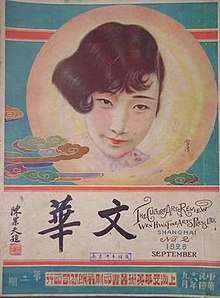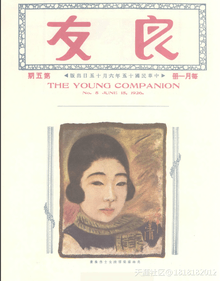Liang Xueqing
Liang Xueqing (梁雪清), also known as Liang Hsüch-ch'ng, was the sister of three well-known Chinese painters and illustrators from the 1930s and 40s. She was an editor for the Wen Hwa (文华) or Culture Arts Review pictorial in the 1930s and was a rarity for promoting female painters in that era.[1] She herself was a painter, from Guangdong, who gained some recognition in 1926, when her self-portrait was published on the front page of the Young Companion, issue 5, a prominent news and cultural pictorial, based in Shanghai and read internationally.[2] She was the first painter on a Liangyou cover as well as the first female painter to be in the pictorial at all, making issue 2.[2] She also had a painting published in issue 3, called Children's Music (儿乐).[2] She painted with oil paints. and with watercolors.[2][1] She was the author of the 1934 book 东北巨变血泪大画史 作者 (The picture history of the great changes of the Northeast and the tears), about the war resisting the Japanese.[3]

Liang Xueqing | |
|---|---|
梁雪清 | |
 Self-painted portrait of Liang Xueqing (梁雪清) on the cover of Liangyou, also known as The Young Companion, issue number 5, June 1926. | |
| Born | Liang Hsüch-ch'ng 1890[1] |
Liang came from a family of artists.[4] Three brothers, as well as three nieces were all were into art.[4] In 1924, her brothers Liang Dingming (梁鼎铭), Liang Youming (梁又铭), and Liang Zhongming (梁中铭), were active members of the painting circles in Shanghai and founded the Tianhua Art Association (天化艺术会), of which she too was a member.[5] She may have joined her brothers in founding the association. Liangyou introduced the group in its pages, one of the first art groups to receive such attention.[5] The group also participated in the Shanghai Union Art Exhibition in 1927, exhibiting artwork.[5]
Liang Xueqing had a professional life, working in the advertising department "of a major company," and he also worked with her brother Dingming who edited the Cultural Pictorial with her.[2] Dingming would become well known for his military art, in particular the mural paintings Huizhou Campaign, (about a battle in 1925, part of the founding of the Republic of China (1912–1949)) which resides in the Taipei Museum of History in Taiwan.[6] Xueqing herself also did military paintings, including "One Day After One Two Eight Eight", which showed the results of Japanese bombing Shanghai.[1] Among her non-military named-paintings are "Lunch" and "Red Snow White", which the Soka Art Center said "pay attention to the meaning of brushwork texture."[1] The center further characterized her work as "smart and free" with "pursuit of a charm in the meaning," using "beautiful and loud" colors.[1]
While her fate is not publicized, her brothers and nieces moved to Taiwan in the 1940s.
External links
References
- "梁雪清(1890-?)[translation:Liang Xueqing ( 1890- ?)". 索卡藝術中心 (Soka Art Center). Retrieved 30 July 2018.
...edited the influential art monthly magazine Wenhua in the 1930s...Through her hand, she introduced girl painters such as Gu Qingyao, Zhou Lianxia, Zhang Mang, Weng Yuanchun, Pan Yuliang, Wang Jingyuan, Zhang Qianying, Zeng Wei, Zeng Huasaw and so on. This care for female painters in the 1930s is unprecedented.
- 楼主 [The Landlord] (5 March 2017). "有没有人一起来扒良友封面女郎 [translation: Does anyone come to Yan Liangyou cover girl?]". Retrieved 29 July 2018.
- "海奇古旧书店出售上万种古旧书刊 [translation: Haiqi ancient bookstore sells tens of thousands of old books and magazines]". junjing.net. Retrieved 30 July 2018.
- Lee, Lily Xiao Hong; Stefanowska, A.D.; Ho, Clara Wing-chun, eds. (1998). Biographical Dictionary of Chinese Women The Twentieth Century 1912-2000. New York: M.E. Sharpe, Inc. p. 321.
- "美展见闻录 上海联合美术展览会 [translation: See you in the exhibition Shanghai United Art Exhibition]". cnarts.net. Retrieved 29 July 2018.
- 严 (Yan), 艺超 (Yichao) (6 January 2017). "梁鼎铭巨幅油画《惠州战役》重现东征风云 [translation:Liang Dingming's huge oil painting "Huizhou Campaign" reproduces the Eastern Expedition]". 东江时报 [Dongjiang Times]. Retrieved 30 July 2018.